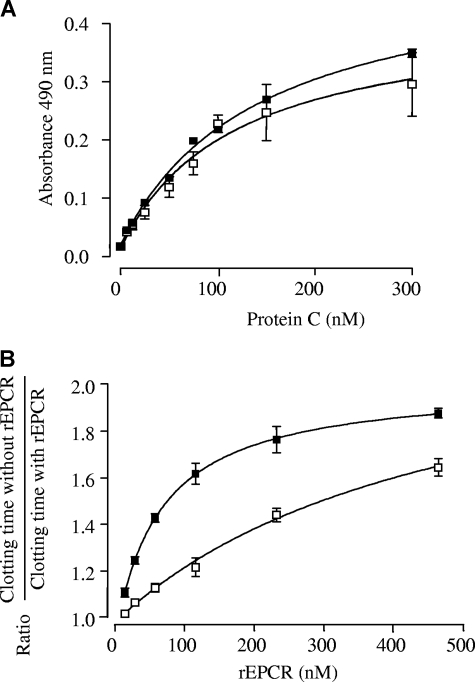Figure 6.
Binding of rWT PC to rEPCRsol and rEPCRisoform, and effect of rEPCRsol and rEPCRisoform on the plasma clotting time. The results in each panel are the mean of at least 3 separate experiments. (A) Binding of rWT PC to rEPCRsol (■) and to rEPCRisoform (□) in the presence of CaCl2 and MgCl2. REPCRsol and rEPCRisoform were captured by 400 ng of immobilized polyclonal antibody to EPCR. Various dilutions of rWT PC were added to the wells in the presence of 1.3 mM Ca2+ and 0.6 mM Mg2+, and bound rWT PC was detected with a peroxidase-conjugated anti-PC polyclonal antibody. Solid curves were obtained by nonlinear regression analysis.30 They yielded Kdapp values of 142 nM and 134 nM for rEPCRsol and rEPCRisoform, respectively. The data represent values (mean ± SD) of 4 separate experiments. The standard deviation is not apparent at all points because they are sometimes smaller than the symbols. (B) Increasing concentrations of rEPCRsol (■) and rEPCRisoform (□) were incubated for 2 minutes at 37°C with APC (1.8 nM, final concentration) in the presence of phospholipid vesicles, RVV-X, and PC-deficient plasma. Clotting was initiated by adding 14 mM CaCl2 (final concentration), and the clotting time was recorded by an ST4 analyzer. The APC-inhibiting effect of the 2 recombinant proteins was expressed as the following ratio: Clotting time in the presence of APC alone/Clotting time in the presence of both APC and rEPCRsol or rEPCRisoform. The standard deviations are not visible at all points because they are sometimes smaller than the symbols.

